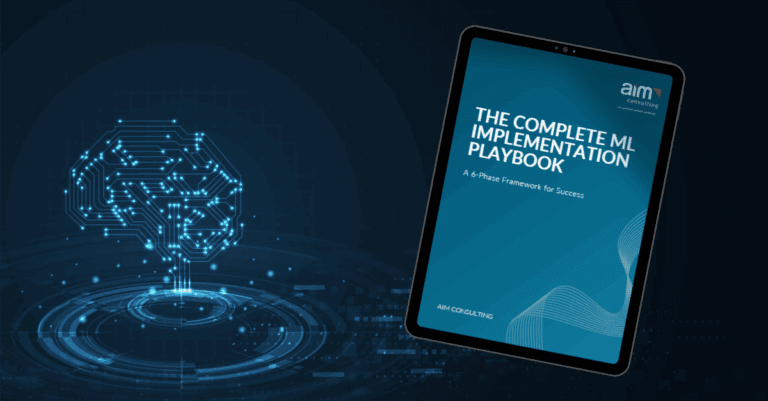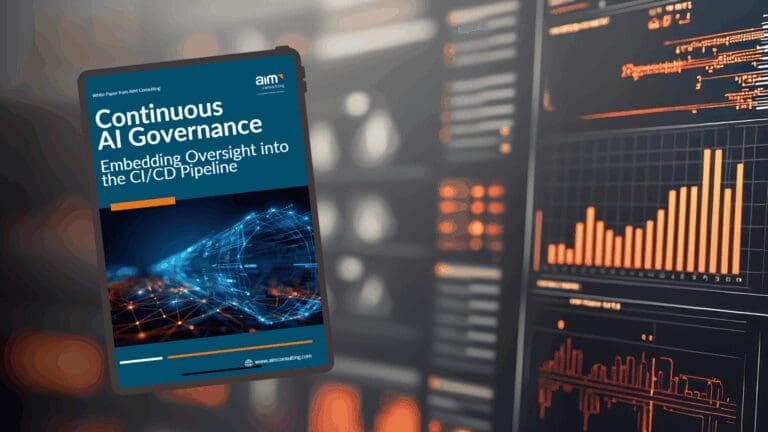
From Lessons to Action: Your Step-by-Step ML Implementation Guide
In our companion article, “Machine Learning Implementation Wins and Failures: Lessons from the Field,” we explored the patterns that separate successful ML projects from costly failures. The most frequent question we receive is: “These insights are valuable—but how do I actually implement them?”
This playbook provides the answer: a concrete, phase-based framework with specific timelines, deliverables, and success criteria for each stage of your ML journey. Rather than general principles, you’ll get actionable steps that translate field-tested lessons into measurable outcomes.
This guide is for teams ready to move beyond experimentation and deliver business value. The six phases below represent distilled wisdom from our most successful implementations, organized into a practical roadmap that avoids common pitfalls while capitalizing on proven success patterns.
Download the Full Guide
Ready to transform your ML initiatives from experiments into business value?
Download this complete implementation framework and start building your roadmap to production success today.
Download Today
Phase 1: Problem Definition & Feasibility (Weeks 1-3)
Key Actions:
- Write a one-page business case linking ML to specific, measurable outcomes
- Conduct stakeholder interviews to validate problem importance and solution constraints
- Perform initial data assessment: availability, quality, and legal/ethical considerations
- Define success metrics that align with business KPIs (not just model accuracy)
Deliverables:
- Business case document with ROI projections
- Stakeholder requirements matrix
- Data availability report with gap analysis
- Success criteria definition (e.g., “Reduce pipeline downtime by 20% within 6 months”)
Go/No-Go Criteria:
- Business value potential > $X or Y% improvement
- Required data exists or can be obtained within 30 days
- Executive sponsorship confirmed
Phase 2: Data Foundation (Weeks 4-5)
Key Actions:
- Establish data governance framework and access permissions
- Build automated data pipelines with quality monitoring
- Create labeled datasets with subject matter expert validation
- Set up data versioning and lineage tracking
Deliverables:
- Exploratory Data Analysis report for each dataset
- Client-aligned data element definitions (lightweight data governance/business glossary process)
- Simple scripts/processes to extract datasets deterministically
- Initial Feature Engineering documentation
Success Indicators:
- <5% missing values in critical features
- Data refresh cycle matches business needs (daily/weekly/monthly)
- SME validation accuracy >90% on sample datasets
Phase 3: MVP Development (Weeks 6-9)
Key Actions:
- Build minimum viable model focused on core use case
- Implement baseline monitoring and drift detection
- Create simple user interface for business stakeholder testing
- Establish model versioning and reproducibility standards
Deliverables:
- Working model with documented performance metrics
- A/B testing framework for comparing model vs. current process
- User feedback collection system
- Technical documentation for handoff
Success Thresholds:
- Model performance beats current process by 15%+ on key metric
- Inference time <2 seconds for real-time use cases
- 5+ business users can successfully interpret outputs
Phase 4: Production Readiness (Weeks 10-15)
Key Actions:
- Implement full MLOps pipeline (CI/CD, automated testing, deployment)
- Build comprehensive monitoring for model performance and business impact
- Create fallback mechanisms for model failures
- Develop user training materials and change management plan
- Automate data ingestion pipeline with quality monitoring
- Establish comprehensive data governance framework and access permissions
- Set up data versioning and lineage tracking
Deliverables:
- Automated deployment pipeline with rollback capabilities
- Real-time monitoring dashboard for technical and business metrics
- Incident response playbook
- User training program with certification process
- Automated data pipeline with 99% uptime SLA
- Data quality dashboard with automated alerts
- Complete data governance documentation and processes
Production Criteria:
- Automated deployment pipeline with rollback capabilities
- Real-time monitoring dashboard for technical and business metrics
- Incident response playbook
- User training program with certification process
- Automated data pipeline with 99% uptime SLA
- Data quality dashboard with automated alerts
- Complete data governance documentation and processes
Phase 5: Launch & Adoption (Weeks 16-19)
Key Actions:
- Deploy to production with limited user group (pilot)
- Collect user feedback and iterate on interface/workflow
- Monitor business impact metrics against baseline
- Scale to full user base based on adoption success
Deliverables:
- Production deployment to pilot group (20% of users)
- Weekly business impact reports
- User adoption metrics and feedback analysis
- Scaled deployment plan
Success Metrics:
- 70% of pilot users actively using system after 30 days
- Business metric improvement matches or exceeds projections
- <10% of predictions require manual override
Phase 6: Optimization & Scale (Weeks 20+)
Key Actions:
- Implement continuous learning from production data
- Expand to adjacent use cases or user groups
- Optimize model performance and infrastructure costs
- Document lessons learned for future ML projects
Ongoing Deliverables:
- Monthly model performance and business impact reviews
- Quarterly roadmap updates based on user feedback
- Cost optimization reports
- Best practices documentation for next ML initiatives
Scaling Indicators:
- Model accuracy maintains or improves over time
- User satisfaction scores >8/10
- ROI exceeds initial projections by Month 6
Risk Mitigation at Each Phase
- Data Issues: Always maintain 2-week buffer in timeline for data quality problems
- Stakeholder Changes: Lock requirements after Phase 1; manage scope creep through formal change process
- Technical Debt: Allocate 20% of development time to infrastructure and monitoring
- Adoption Resistance: Include end users in design process from Phase 2 onward
This framework gives teams a concrete roadmap with specific checkpoints, measurable outcomes, and realistic timelines based on common ML project patterns. Read the companion article, “Machine Learning Implementation Wins and Failures: Lessons from the Field,” to explore the common patterns that separate successful ML projects from costly failures.
Ready to transform your ML initiatives from experiments into business value?
Contact AIM to start building your roadmap to production success today.





